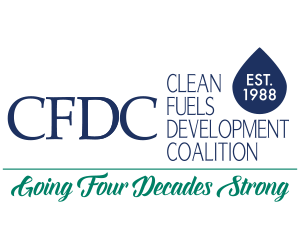In testimony today to the U.S. Environmental Protection Agency on the new fuel economy rules, the Clean Fuels Development Coalition (CFDC) challenged the agency’s omission of any mention of clean octane even though they had previously acknowledged the relevance to fuel economy and reduced emissions.
“We think it’s a fair question for us to ask–what happened?” said CFDC Executive Director Doug Durante. Not only did EPA previously solicit comments on how high octane fuels could help meet the objectives of the fuel economy rule but they also were provided more updated data, particularly with respect to health impacts. Higher octane if instituted in concert with a control on toxic compounds currently used to increase octane would reduce a range of harmful emissions, which EPA had stated was a priority in the rule.
“EVs will not provide significant benefits for many years and during that time we will continue to rely on internal combustion engines operating on gasoline. If the objective is to decarbonize our transportation fuels, and gasoline is the predominant fuel in the transportation sector with approximately 125 billion gallons of gasoline consumed annually, it should be obvious that is where we start,” said Durante.
“Aromatics like benzene and the family of benzene ringed aromatics are the primary source of octane and produce fine particulates which are contributing to a range of negative health impacts. We have abundant supply of non toxic, low carbon, high octane ethanol that can meet the octane demand and replace those aromatics”.
Durante called on EPA to acknowledge the positive role of octane in the final rule and at a minimum set the stage for future agency action to increase the minimum standards.
CFDC Testimony To EPA on The Revision of the Fuel Economy Rule
Good Morning, my name is Doug Durante, I am the executive director of the Clean Fuels Development Coalition, a nonprofit organization supporting policies and programs to reduce our use of petroleum and improve air quality.
We commend EPA for your efforts in this rule, we recognize it it is a complex technical and legal challenge.
This rule makes the Administration’s preference clear with regard to Electric Vehicles. Done right, EVs can play a key role in our collective efforts to increase vehicle efficiencies and reduce pollution.
Our issue with this rule is what it does not do, which is to acknowledge that under even the most optimistic scenarios EVs will not provide significant benefits for many years and during that time we will continue to rely on internal combustion engines operating on gasoline.
If the objective is to decarbonize our transportation fuels, and gasoline is the predominant fuel in the transportation sector with approximately 125 billion gallons of gasoline consumed annually, it should be obvious that is where we start. We sell 12-15 million new cars every year that have an average road life of 12 years. Even as EVs chip away and capture market share, gasoline will remain the primary fuel. We will drive trillions of miles over the next decade on gasoline.
The way we can make that gasoline more efficient and less of a carbon and ghg emitter is to give automakers the tools they need, the key one being a higher minimum octane standard.
We are puzzled how you could recognize octane when the SAFE Rule was developed in 2020 but not now. I use the word recognize loosely because you did not take any action on octane but at least solicited comments on how high octane could contribute to the objectives of increased efficiency and reduced emissions, what the optimum levels were, what kinds of benefits could be expected, what other issues would arise, and importantly, how it could be done consistent with title II of the Clean Air Act, which among other things establishes controls over air toxics.
We feel like it’s a fair question for us to ask what happened? You say in the rule you have updated the analysis from the 2020 final rule, we provided detailed information on the octane issue then and asked EPA to ask for comment again so we could provide even more compelling data and information. You did not even ask.
Increasing octane allows automakers to get better mileage, plain and simple. This is not a futuristic vision, while future cars can absolutely maximize high octane fuels, these gains can also be achieved now, with todays cars, and this is verified by the auto industry in correspondence we had shared with you.
The other half of the story is that increasing octane while ensuring it does not come from aromatic compounds not only tackles the highest carbon component in gasoline, but also the most deadly. I quote from this proposed rule a statement that EPA has “changed its position” and “it is more appropriate to place greater weight on the magnitude and benefits of reducing emissions that endanger public health and welfare….” .
Aromatics like benzene and the family of benzene ringed aromatics are the primary source of octane and produce fine particulates which are contributing to a range of negative health impacts. We have abundant supply of non toxic, low carbon, high octane ethanol that can meet the octane demand and replace those aromatics..
We ask that in the final regulatory analysis for this rule and in the preamble and anything else EPA puts out to acknowledge the need to focus on gasoline and if we supply information on octane in our comments it not be disregarded as outside the scope of this rule just because it is not in it now.
Thank you.
